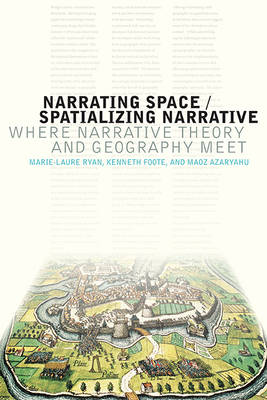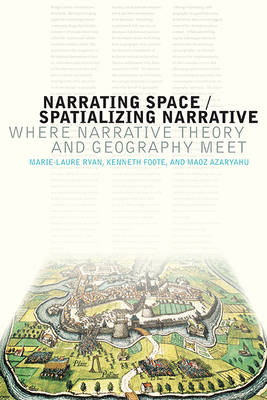
- Afhalen na 1 uur in een winkel met voorraad
- Gratis thuislevering in België vanaf € 30
- Ruim aanbod met 7 miljoen producten
- Afhalen na 1 uur in een winkel met voorraad
- Gratis thuislevering in België vanaf € 30
- Ruim aanbod met 7 miljoen producten
Zoeken
Narrating Space / Spatializing Narrative
Where Narrative Theory and Geography Meet
Marie-Laure Ryan, Kenneth Foote, Maoz Azaryahu
€ 131,45
+ 262 punten
Uitvoering
Omschrijving
Narrating Space / Spatializing Narrative: Where Narrative Theory and Geography Meet by Marie-Laure Ryan, Kenneth Foote, and Maoz Azaryahu offers a groundbreaking approach to understanding how space works in narrative and narrative theory and how narratives work in real space. Thus far, space has traditionally been viewed by narratologists as a backdrop to plot. This study argues that space serves important but under-explored narrative roles: It can be a focus of attention, a bearer of symbolic meaning, an object of emotional investment, a means of strategic planning, a principle of organization, and a supporting medium.
Space intersects with narrative in two principal ways: ''Narrating space'' considers space as an object of representation, while ''spatializing narrative'' approaches space as the environment in which narrative is physically deployed. The inscription of narrative in real space is illustrated by such forms as technology-supported locative narratives, street names, and historical/heritage site and museum displays. While narratologists are best equipped to deal with the narration of space, geographers can make significant contributions to narratology by drawing attention to the spatialization of narrative. By bringing these two approaches together--and thereby building a bridge between narratology and geography--Narrating Space / Spatializing Narrative yields both a deepened understanding of human spatial experience and greater insight into narrative theory and poetic forms.
Space intersects with narrative in two principal ways: ''Narrating space'' considers space as an object of representation, while ''spatializing narrative'' approaches space as the environment in which narrative is physically deployed. The inscription of narrative in real space is illustrated by such forms as technology-supported locative narratives, street names, and historical/heritage site and museum displays. While narratologists are best equipped to deal with the narration of space, geographers can make significant contributions to narratology by drawing attention to the spatialization of narrative. By bringing these two approaches together--and thereby building a bridge between narratology and geography--Narrating Space / Spatializing Narrative yields both a deepened understanding of human spatial experience and greater insight into narrative theory and poetic forms.
Specificaties
Betrokkenen
- Auteur(s):
- Uitgeverij:
Inhoud
- Aantal bladzijden:
- 312
- Taal:
- Engels
- Reeks:
Eigenschappen
- Productcode (EAN):
- 9780814212998
- Verschijningsdatum:
- 16/03/2016
- Uitvoering:
- Hardcover
- Formaat:
- Genaaid
- Afmetingen:
- 160 mm x 234 mm
- Gewicht:
- 498 g

Alleen bij Standaard Boekhandel
+ 262 punten op je klantenkaart van Standaard Boekhandel
Beoordelingen
We publiceren alleen reviews die voldoen aan de voorwaarden voor reviews. Bekijk onze voorwaarden voor reviews.











